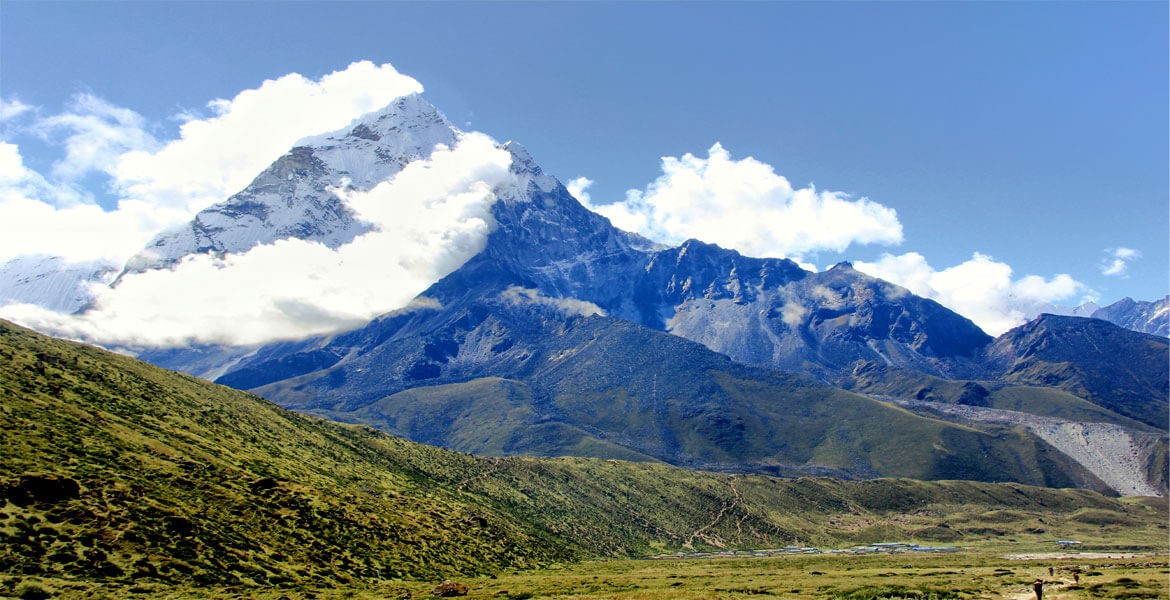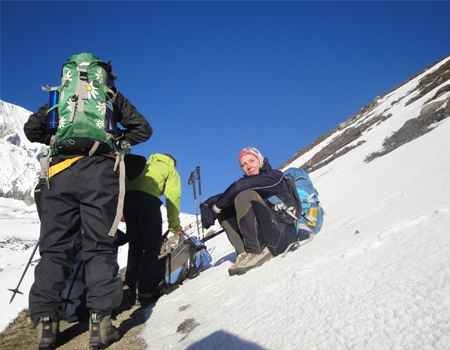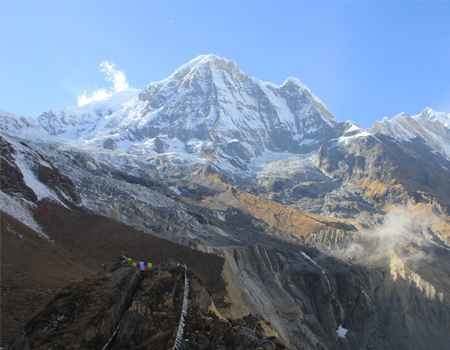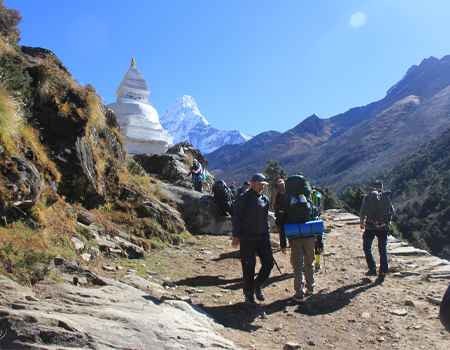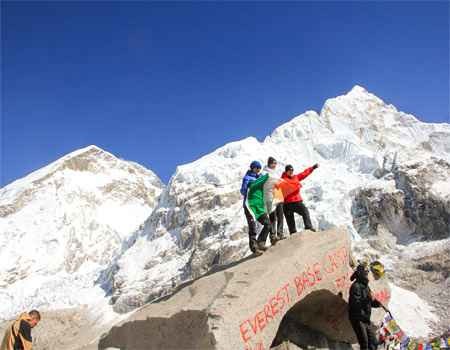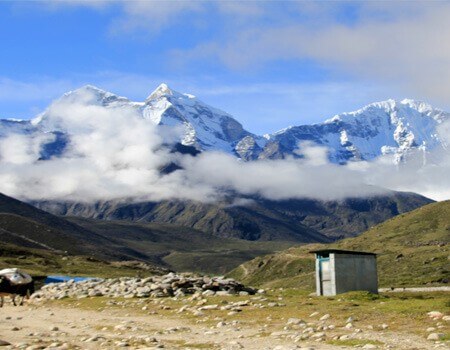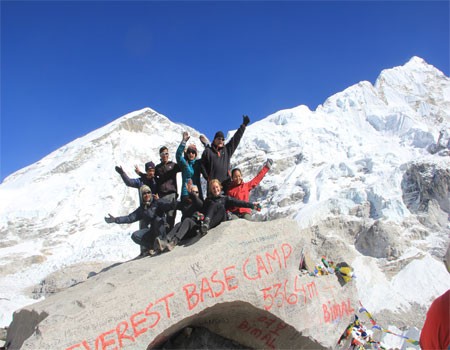The Everest Base Camp trek is a dream for many adventure trekkers to step at the foot of the world's highest peak at least once in a lifetime. The journey is a symphony of breathtaking landscapes, rich Sherpa culture, and personal achievement. You must choose the right time to create an unforgettable memory and a lifetime experience. So, September is one of the best months to trek to the Everest Base Camp. As the monsoon rains recede, they wash away the haze of the dry season, making valleys green, the crystal-clear air, and the snow-capped Himalayas bright with brilliant blue skies. However, there are a few rainy days until mid-September, and flights to Lukla might have been cancelled often. The trek is challenging, with extended hours of walking each day and the effects of high altitude. However, with the proper preparation, it's a rewarding and achievable goal.
This blog post provides essential information on the Everest Base Camp trek in September, covering weather and preparation, as well as the daily trail experience, to ensure you are fully equipped for this unforgettable journey.
Why September is a Perfect Month for Your Everest Base Camp Adventure
September is the beginning of the autumn season in Nepal, when optimal conditions apply. It is a month that offers a unique blend of summer's lushness and autumn's clarity.
Post-Monsoon Clarity and Scenery
The preceding monsoon season, from June to August, bathes the landscape in rain, settling the dust and clearing the haze from the atmosphere. The result is that in September, trekkers are rewarded with apparent and far-reaching views of the Himalayas. The high snow-capped mountains of the Everest Himalayas, like Everest, Lhotse, Nuptse, and the stunning Ama Dablam, appear sharp and majestic with the deep blue sky in autumn. The lower parts of the trail are draped in a vibrant green blanket, as the monsoon moisture gives life to the vegetation, making the forests and terraced fields look incredibly fresh and alive. Waterfalls and rivers also appear large and impressive due to recent rains.
Ideal Weather and Tolerable Temperatures
The weather in September is generally stable and pleasant, making for comfortable trekking days. While the first couple of weeks might see some lingering, light rainfall, especially at lower elevations, the latter half of the month is typically dry and sunny. The temperatures are moderate—neither too hot at lower altitudes nor excessively cold higher up. Daytime temperatures will range from 15°C to 20°C (59°F to 68°F) in the lower regions. At the same time, at higher elevations, such as Gorak Shep (the last stop before base camp), they average around 3°C to 10°C (37°F to 50°F). Temperatures at night are colder and drop to minus degrees at altitudes above 4,000 meters. Still, the temperatures are far more tolerable than in the winter months. This balance of clear skies and manageable temperatures makes September a prime window for the trek.
Fewer Crowds, More Serenity
As September is the very beginning of the peak autumn trekking season, the trails are significantly less crowded, offering a more peaceful and personal experience with the mountains. The popular viewpoints are less congested, and the trails provide a sense of solitude that can be lost during the busier months. This quieter atmosphere also makes it easier to find accommodation in the teahouses along the route, with no need to book far in advance. You'll receive more personal attention from your hosts and have a better chance to connect with the local Sherpa culture in a more relaxed setting.
Cultural Festivals
According to the Nepali lunar calendar, September has Nepal's most vibrant Hindu festivals either before or after your trek in Kathmandu. These festivals include Teej, a colorful festival celebrated by women, and Indra Jatra, a lively Kathmandu Valley festival featuring masked dances and chariot processions. Teej is the most important women's festival. Married women worship the God Shiva, seeking a longer life for their husbands, and unmarried girls aspire to find a perfect partner. They do fasting, dance, and sing on this day. Indra Jatra is a week-long festival that marks the end of the monsoon season and the beginning of the harvest season, featuring a diverse range of cultural performances, including masked dances and chariot processions. Experiencing these cultural events can add another fascinating layer to your Himalayan adventure.

Beautiful weather Everest base camp
Preparing for Your September Trek: Mind and Body
A successful trek to Everest Base Camp is not just about purchasing the plane ticket and walking to the mountain with the gear. You must be well-prepared both physically and mentally to navigate carefully through high mountain altitudes with potential obstacles.
Mental Fortitude: The First Step to the Himalayas
The journey to Everest Base Camp is as much a mental challenge as a physical one. You will be walking for several hours a day for nearly two weeks, often on rugged terrain. The accommodation is basic in the mountains, and the effects of high altitude can arise as you ascend to higher elevations. Mental preparation is key to a successful trip.
Start by researching the trek thoroughly. Understand the potential challenges, including the possibility of flight delays to and from Lukla, the symptoms of altitude sickness, and the nature of teahouse accommodations. During the trek, teahouses are small, family-run establishments in most areas he places that offer basic accommodations and meals. They are a common form of lodging along the Everest Base Camp trek. Set realistic expectations; this is not a luxury holiday, but an adventure that will push your boundaries. Cultivate a positive and flexible mindset. If the Lukla flight is cancelled or you need an extra rest day, see it as part of the experience rather than a setback. The ability to remain patient, optimistic, and adaptable is one of the most valuable tools you can possess.
Physical Conditioning: Building Your Endurance
While you don't need to be a professional athlete, a good level of physical fitness is enough for enjoying the trek safely. There are some long, ascending and descending trails in certain parts of the trek. Being physically prepared will not only make the walk more pleasant but also help your body cope with the stress of altitude.
It's recommended to start a training regimen at least three to four months before your departure. Your training should focus on three key areas:
- Cardiovascular Fitness: Activities such as running, cycling, swimming, and brisk walking are excellent for building cardiovascular stamina. Aim for 3-4 sessions per week, gradually increasing the duration and intensity of each session.
- Strength Training: Focus on strengthening your legs and core. Exercises like squats, lunges, and step-ups will build the leg muscles needed for the long ascents and descents. A strong core will help with stability and carrying a daypack.
- Hiking Practice: The best way to train for a trek is to go hiking. Find local trails with hills and uneven terrain. Start with shorter hikes and gradually build up to longer durations. Crucially, train while wearing the same boots you'll use in Nepal and carry a backpack with some weight in it to simulate the conditions of trekking.
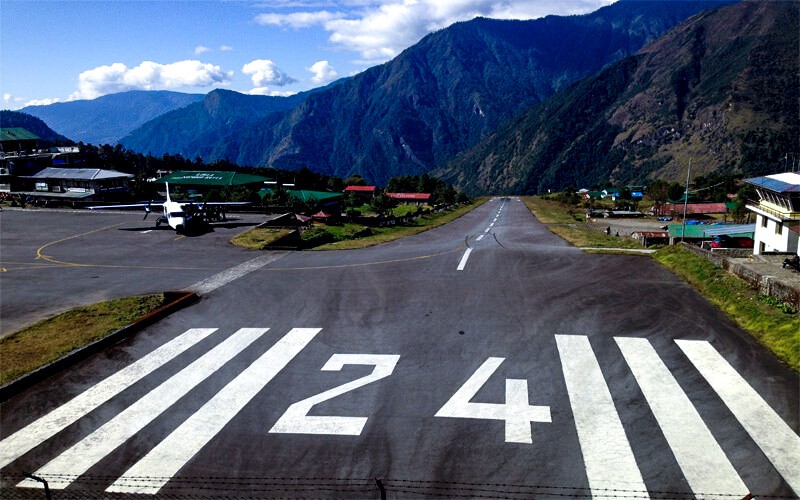
Lukla airport
The Journey to Everest Base Camp: A Day-by-Day Itinerary
The classic Everest Base Camp trek typically takes around 12 to 14 days, allowing for proper acclimatization. Here's a narrative of what you can expect on the trail.
Days 1-2: Arrival in Kathmandu and the Thrilling Flight to Lukla
Your adventure begins in Kathmandu (Nepal's capital). After arriving, you'll take a day to prepare, perhaps picking up some last-minute gear. The real excitement starts on day two with an early morning flight to Lukla. This 30-minute flight is an adventure in itself, offering your first stunning views of the Himalayas as you fly parallel to the mountain range. The landing at Tenzing-Hillary Airport in Lukla, with its short, angled runway perched on a mountainside, is an unforgettable experience. From Lukla (2,860m), you'll meet your guide and porter and begin the first leg of the trek, a relatively easy walk to Phakding (2,610m).
Days 3-5: The Lower Khumbu Valley - Phakding to Namche Bazaar
The trail from Phakding follows the Dudh Koshi ("Milk River"), a glacial river with a distinctive color. You'll cross several iconic suspension bridges, festooned with colorful prayer flags, and pass through small Sherpa villages. The main event of this section is the steep, sustained climb to Namche Bazaar (3,440m), the administrative and trading hub of the Khumbu region. After the challenging ascent, arriving in the amphitheater-shaped town of Namche is a welcome sight. You'll spend an extra day here to acclimatize, which is crucial for preventing altitude sickness. You can spend the day exploring the town's shops and bakeries or take a short hike to a nearby viewpoint for your first glimpse of Mount Everest.
Days 6-8: Ascending to Higher Altitudes - Tengboche to Dingboche
Leaving Namche, the trail offers spectacular views of Ama Dablam, often called the most beautiful mountain in the Himalayas. The path leads to Tengboche (3,870m), home to the region's largest and most important Buddhist monastery. A visit to the monastery, perhaps to listen to the monks' evening chants, is a profound cultural experience. From Tengboche, the landscape begins to change, with trees becoming scarcer as you move into a more alpine environment. The trail continues to Dingboche (4,360m), where you'll have another vital acclimatization day. A recommended acclimatization hike is to Nangkartshang Peak, which provides panoramic views of several giant peaks, including Makalu and Lhotse.
Days 9-10: The Final Push - Lobuche to Gorak Shep and Everest Base Camp
From Dingboche, you trek into the high-altitude wilderness. The path now runs alongside the lateral moraine of the massive Khumbu Glacier. You'll pass a memorial area with stone cairns dedicated to climbers who have lost their lives on Everest, a sobering reminder of the mountain's power. The next stop is Lobuche (4,940m), a small settlement with basic lodges. From Lobuche, it's a few more hours of trekking over glacial moraine to Gorak Shep (5,170m), the last outpost of civilization. After dropping your bags and having a quick lunch, you'll undertake the final push to Everest Base Camp (5,364m). Reaching the base camp, a sprawling city of tents during the climbing season, is an emotional moment. While you can't see the summit of Everest from here, you are standing at the foot of the giant, with the formidable Khumbu Icefall tumbling down right in front of you.
Day 11: The Ultimate Viewpoint - Kala Patthar and the Descent
The highlight for many trekkers comes before dawn on day 11. A challenging, cold hike up to the summit of Kala Patthar (5,545m) rewards you with the most iconic and breathtaking sunrise view of Mount Everest. As the sun's first rays hit the summit, the world's highest peak is bathed in a golden light, which is the postcard view you've been working towards. After soaking in the panoramic spectacle, you'll descend back to Gorak Shep for breakfast and then begin the long journey back down the valley, usually trekking to Pheriche (4,270m) on the same day.
Days 12-14: The Return Journey - Pheriche to Lukla and Flight to Kathmandu
The descent is much faster than the ascent, but it can still be tough on the knees. You'll retrace your steps through the familiar landscapes and villages, enjoying the thicker air as you lose altitude. The journey back to Lukla typically takes two to three days. After a final night celebrating with your trekking crew in Lukla, you'll take the scenic flight back to Kathmandu, your heart and mind filled with the incredible memories of your Himalayan adventure.
Weather and Temperature in Detail: What to Expect in September
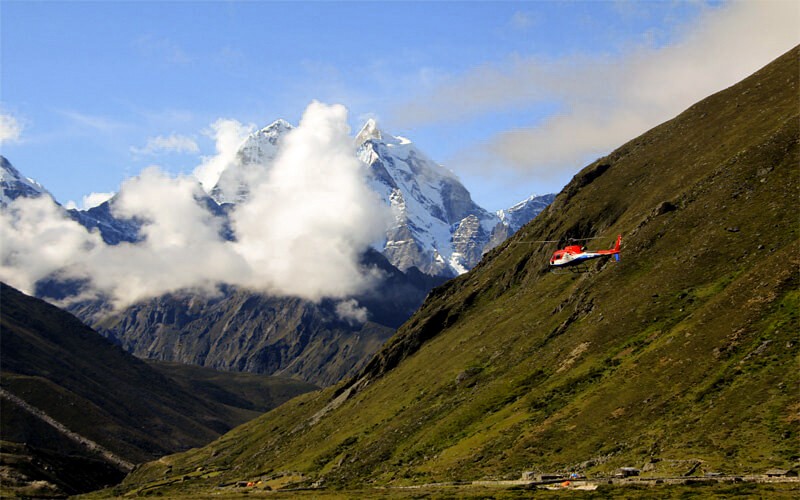
Helicopter flight to Everest base camp
The weather in the Everest region is notoriously unpredictable, but September generally offers favorable conditions.
Early September vs. Late September
The first two weeks of September are considered post-monsoon. You might still encounter occasional rain showers, especially in the afternoons and at lower altitudes. The trails can be a bit muddy in places. However, these rains are usually short-lived and won't be the continuous downpours of the monsoon season. From mid-September onwards, the weather becomes much more stable and dry, with clear skies dominating. Late September is often considered the ideal time for trekking.
Temperature by Altitude
Temperatures vary significantly with altitude.
- Lukla (2,829m): Daytime temperatures average around 13.5°C (56°F), with nighttime lows around 9.5°C (49°F).
- Namche Bazaar (3,463m): Expect daytime temperatures around 10°C (50°F), dropping to about 5°C (41°F) at night.
- Dingboche (4,483m): Daytime temperatures are cooler, averaging 6°C (43°F), with nights dropping to freezing or just below.
- Gorak Shep (5,180m): Here, it is cold year-round. In September, daytime temperatures might hover around 3°C (37°F), while nighttime temperatures can plummet to -10°C (14°F) or colder.
Wind and Sunshine
September is generally a calm month in the Everest region, with average wind speeds around 12 km/hr (7.4 mph). You can expect a good amount of sunshine, particularly in the mornings. On average, there are approximately 12 hours of clear weather and sunshine per day at lower elevations, and around 8 to 9 hours at higher altitudes, such as Gorak Shep.
You can read the other blog about the weather and temperature of the Everest Base Camp trek in detail, which provides a brief overview of different seasons and months.
Accommodation, Food, and Drink on the Trail
The Everest Base Camp trek is a teahouse trek, meaning you'll stay in small lodges each night rather than camping.
Teahouse Experience
Teahouses are family-run establishments that offer basic yet comfortable accommodations. A typical teahouse has a central dining hall with a stove that is lit in the evenings, creating a warm and social atmosphere where trekkers gather. Bedrooms are usually simple twin rooms with two wooden beds, mattresses, and pillows. You will need your sleeping bag for warmth and hygiene. Bathrooms are often shared and can be very basic, especially at higher altitudes. Some teahouses offer hot showers for an extra fee. For those seeking more comfort, luxury lodges with private bathrooms and better amenities are available in some villages along the trail.
Food on the Trek
The teahouses offer surprisingly extensive menus, with food being either flown into Lukla or carried up by porters and mules. The staple dish is Dal Bhat, a traditional Nepali meal of lentil soup, rice, and a vegetable curry. It's nutritious, filling, and you can usually get free refills, making it a favorite among trekkers and guides. Other standard options include Sherpa stew, Tibetan bread, momos (dumplings), pasta, pizza, and various potato and egg dishes. It is widely recommended to stick to vegetarian food above Namche Bazaar. Since the region is Buddhist, there is no butchering of animals. Any meat has to be carried up from lower altitudes without refrigeration, which increases the risk of it spoiling.
Staying Hydrated
Drinking plenty of water (3-4 liters per day) is essential for acclimatization and overall health on the trek. You have a few options for drinking water. You can purchase bottled water from the teahouses, but this is an expensive option that generates plastic waste. A more environmentally friendly and economical option is to treat your water. You can fill your bottle with tap water (available at every teahouse) and purify it using iodine or chlorine tablets, a UV sterilizer like a SteriPEN, or a water filter.
Navigating the Challenges of a September Trek
While September is a great time to trek, there are still challenges to be prepared for.
Flight Delays to Lukla
The weather in the mountains can change rapidly, and the Lukla airport requires clear visibility for planes to land and take off safely. Flights to Lukla often experience delays and cancellations, even during the peak season. The best way to handle this is to build at least two buffer days into your itinerary at the end of your trip. This way, if your flight out of Lukla is delayed by a day or two, you won't risk missing your international flight home. If you are on a tight schedule, chartering a helicopter is a more reliable, albeit much more expensive, alternative.
Altitude Sickness (Acute Mountain Sickness - AMS)
AMS is a serious risk on any high-altitude trek and should not be underestimated. It is caused by ascending too quickly without giving your body enough time to adjust to the lower oxygen levels. Symptoms can include headache, nausea, dizziness, and fatigue. To prevent AMS, the golden rules are to stroll ("bistari, bistari" in Nepali), drink plenty of water, and acclimatize properly. The standard itineraries include essential acclimatization days for this reason. If you experience symptoms of AMS, do not ascend any higher. Rest, and if the symptoms don't improve, descend to a lower altitude. Some trekkers choose to take Diamox (acetazolamide) as a prophylactic, but this should be discussed with your doctor before the trip.
Trail Conditions
In early September, there's a chance of encountering wet and slippery trails due to residual monsoon rain. Waterproof hiking boots with good grip are essential. Using trekking poles can also provide extra stability on tricky sections. Always carry your rain gear in your daypack, as mountain weather can be unpredictable.
Essential Gear List for a September Everest Trek
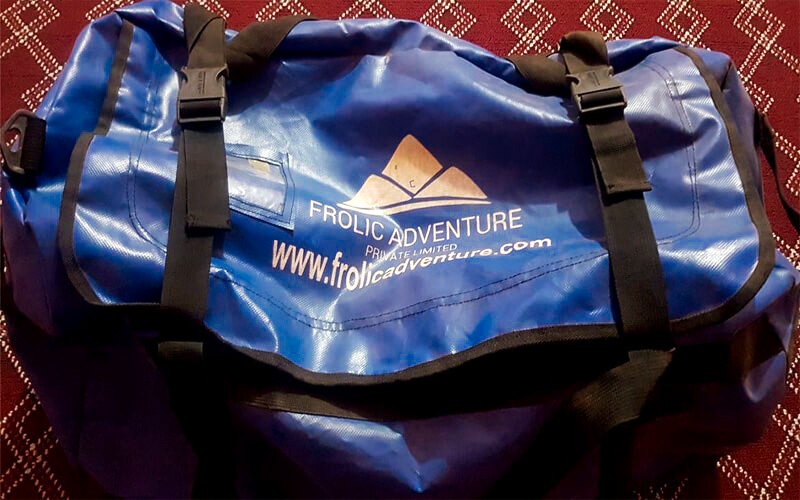
Main Bag for Trekking Gear
Packing the right gear is crucial for a safe and comfortable trek. The key is layering, as you'll experience a wide range of temperatures.
Clothing (Layering System)
- Base Layer: Moisture-wicking thermal tops and bottoms.
- Mid-Layer: A fleece jacket or two for warmth.
- Outer Layer: A warm down jacket for cold evenings and mornings, and a waterproof/windproof jacket and pants for protection against rain and wind.
- Trekking Clothes: Several pairs of trekking shirts (both short and long-sleeved) and trekking trousers or convertible pants.
Footwear
- Trekking Boots: Waterproof, ankle-supporting boots that are well broken-in.
- Camp Shoes: A pair of comfortable sneakers or sandals to wear in the teahouses in the evenings.
- Socks: Several pairs of quality wool or synthetic trekking socks.
Equipment
- Backpack and Daypack: A large duffel bag or rucksack (approximately 60-70 liters) for your porter to carry, and a daypack (approximately 30-35 liters) for you to have your daily essentials, such as water, snacks, a camera, and rain gear.
- Sleeping Bag: A four-season sleeping bag rated to at least -10°C (14°F) is recommended.
- Trekking Poles: Highly recommended for saving your knees on descents and for stability.
- Headlamp: Essential for early morning starts and for navigating in the teahouses at night.
Health and Safety
- First-Aid Kit: A personal kit with essentials like pain relievers, blister treatment, antiseptic wipes, and any personal medications.
- Water Purification: Tablets, drops, or a filter system.
- Sun Protection: High SPF sunscreen, lip balm with SPF, and a wide-brimmed hat or cap.
- Sunglasses: High-quality, UV-blocking sunglasses are essential for protecting against snow glare.
Miscellaneous
- Camera and Power Bank: To capture the stunning scenery and keep your electronics charged.
- Nepali Currency: For buying snacks, drinks, souvenirs, and tipping your guide and porter. ATMs are available in Lukla and Namche, but are not always reliable.
The list mentioned above is based on the basics, but we have different blog posts about the gear list for the Everest Base Camp trek. We suggest reading that one; however, some extra equipment is added for the female trekkers.
Shorter Trek and Alternative Options
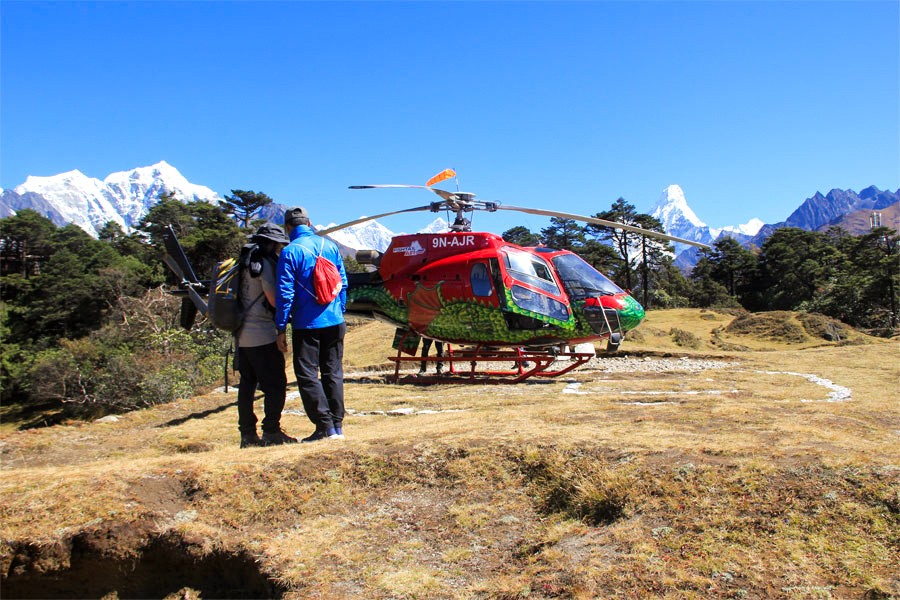
Helicopter Landing near Hotel Everest View
For those with limited time or who are unable to complete the whole trek, there are alternatives.
Everest Base Camp Trek with Helicopter Return
This option allows you to experience the entire trek on the way up, saving time on the return journey. After reaching Everest Base Camp and hiking to Kala Patthar, you can take a helicopter from Gorak Shep or Pheriche back to Lukla or directly to Kathmandu, shortening the trip to around 7-9 days.
Everest Helicopter Tour
For a taste of the Everest experience without the trekking, a helicopter tour is a fantastic option. These tours depart from Kathmandu for the Everest region, often landing near base camp or at Kala Patthar for incredible, close-up views of the mountains, all within a few hours.
Conclusion
Trekking to Everest Base Camp in September offers a truly special experience. It is a time when the Himalayas are at their most vibrant, the air is crisp and clear, and the trails are relatively peaceful. The journey is undoubtedly challenging, testing both physical and mental limits, but the rewards are immeasurable. Standing in the shadow of the world's tallest mountains, surrounded by the raw beauty of the Khumbu and the warm hospitality of the Sherpa people, is an experience that will stay with you forever. With proper preparation and a spirit of adventure, your September trek to Everest Base Camp will be an unforgettable chapter in your life's story.
